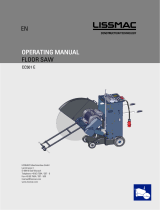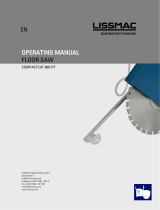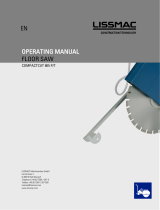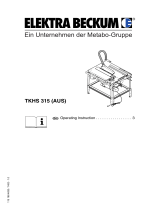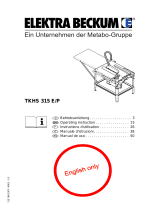Page is loading ...

1/40
OPERATING MANUAL
DRY EXTRACTION SYSTEM
VACUUM DRY 300
LISSMAC Maschinenbau GmbH
Lanzstrasse 4
D-88410 Bad Wurzach
Phone +49 (0) 7564 / 307 - 0
Fax +49 (0) 7564 / 307 - 500
lissmac@lissmac.com
www.lissmac.com
EN

2/40

3/40
Legal Notice This operating manual is valid for:
LISSMAC Dry Extraction System
VACUUM DRY 300
Headquarters:
LISSMAC Maschinenbau GmbH
Lanzstrasse 4
D - 88410 Bad Wurzach
Phone: +49 (0) 7564 / 307 – 0
Fax: +49 (0) 7564 / 307 – 500
lissmac@lissmac.com
www.lissmac.com
Translation of the original operating manual
Issue date: 01/2019
The dissemination or duplication of this operating manual in any form, or the reuse of contents is
forbidden unless permitted in writing.
Non-compliance is subject to compensation for damages. All rights reserved for the purpose of
patent, utility model, or design patent registration.

4/40
BASIC SAFETY INSTRUCTIONS
Warnings and symbols used in these instructions
WARNING LEVELS
Type and source of danger
Consequences if not observed
Measures to take to avert the danger.
The warning levels after the hazard symbol indicates the level of danger:
DANGER This indicates an extremely dangerous situation. If the situation is not avoided, it will likely result in fatal
injuries. The hazard symbol may give details of the danger.
WARNING This indicates a potentially dangerous situation. If the situation is not avoided, it may result in fatal or
severe injuries. The hazard symbol may give details of the danger.
CAUTION This indicates a hazardous situation. If the situation is not avoided, it may result in moderate or minor
injuries. The hazard symbol may give details of the danger.
NOTICE This indicates a situation at risk of damaging machinery or other property. If the situation is not avoided, it
may result in property damage. Caution is used without a hazard symbol.
Important information is marked with an "i".
Request for the operator to take action:
The specified sequence of steps ensures the proper and safe handling of the machine.
Instructions for the operator

5/40
The following warning and safety instructions are used:
Read operating manual.
Wear hearing protection.
Wear safety glasses.
Wear gloves.
Wear protective helmet.
Wear dust mask.
Wear suitable work clothes and wash dusty clothes.
Lifting points for crane transport.
Lubrication point
Hot surfaces. Touching can cause burns.
Danger due to suspended loads.
Danger of getting caught due to open belt drive.
Danger of having your hand crushed.
Wait for all parts to stop.
Danger due to ejected parts.
Risk of being crushed if machine tips over.
Danger of tripping.
No use by unauthorised persons.

6/40
No maintenance while the engine is running.
Sound power level of the machine.
Instruction for damage prevention.
Lashing point for vehicle transport.
Only store and transport the device upright.
Harmful ingredients: Silica dust

7/40
OPERATING MANUAL
Preface This operating manual should make it easier to get to know the machine and make use of
its intended applications.
The operating manual contains important information on how to operate the machine
safely, properly and economically. Your close attention helps avoid risk, repair costs and
downtime, and increase the reliability and lifetime of the machine.
The operating manual is to be supplemented by directives for accident prevention and
environmental protection, according to applicable national requirements.
The operating manual is to be kept permanently available at the machine location.
The operating manual must be read and used by each person assigned to work with the
machine, e.g.:
Operating, including tooling, troubleshooting during operating, correction of
production rejects, service, disposal of operating and auxiliary materials
Maintenance (service, inspection, repair) and/or
Transport
Along with the operating manual and the valid legal regulations for accident prevention in
the country of use and the place of use, also recognised technical regulations for safety
and proper work are to be observed.
Other required machinery A LISSMAC MC 800 or MC 900 floor saw is required for proper use.
Other relevant documents In addition to these assembly instructions, further documentation is available from the
manufacturers of individual machine components:
Floor saw’s operating manual
LISSMAC assumes no responsibility or liability for the completeness of this list.
Changes and reservations We have taken every effort to ensure that these assembly instructions are correct and up
to date. In order to maintain our technological edge, it may be necessary to make changes
to the product and its operation without notice. We accept no liability for faults,
downtime, or any resulting damages.

8/40
Notes:

9/40
Table of contents
Features & Benefits ....................................................................................................... 10
General safety instructions
........................................................................................... 11
2.1. Proper use ....................................................................................................................... 11
2.2. Organisational Measures................................................................................................ 12
2.3. Choice of personnel and - qualification; fundamental obligations .................................. 12
2.4. Safety notes regarding the operating phases ................................................................. 13
2.4.1. Transport, assembly, and installation .................................................................... 13
2.4.2. Putting the system into service .............................................................................. 13
2.4.3. Operation ............................................................................................................... 13
2.4.4. Special work while using the machine .................................................................. 14
2.4.5. Note about particular risks..................................................................................... 14
2.4.6. Electrical power ..................................................................................................... 15
2.4.7. Dust........................................................................................................................ 15
2.4.8. Noise ...................................................................................................................... 15
2.5. Packaging and storage .................................................................................................... 16
2.6. Environmental protection ................................................................................................ 16
2.7. Disposal .......................................................................................................................... 16
Device Description......................................................................................................... 17
3.1. Designation of machine parts ......................................................................................... 17
3.2. Technical Data ................................................................................................................ 18
3.5. Mount extraction system on the floor saw ..................................................................... 20
3.6. Changing the dust collecting bag .................................................................................... 22
Transport ........................................................................................................................ 24
4.1. Transport position ........................................................................................................... 24
4.2. Relocating using a crane................................................................................................. 25
4.3. Securing the machine for transport ................................................................................ 26
Operation ........................................................................................................................ 27
5.1. Safety ............................................................................................................................. 27
5.2. Cutting operation ............................................................................................................ 28
5.3. Shaking the filter cartridges ........................................................................................... 29
5.4. Replace air filter cartridges ............................................................................................ 30
5.5. Tensioning and changing the V-belt ............................................................................... 31
Maintenance .................................................................................................................. 32
6.1. Servicing ......................................................................................................................... 32
6.3. Troubleshooting .............................................................................................................. 34
6.4. Torques of screw connections ........................................................................................ 35
6.5. Maintenance plan ........................................................................................................... 36
Warranty......................................................................................................................... 37
Circuit diagram ............................................................................................................... 39

10/40
FEATURES & BENEFITS
The VACUUM DRY dry extraction system removes sawdust quickly and easily from the joint cutting
during the sawing process. This keeps the saw blade from being slowed down by the build-up of
material. This helps the machine run more quickly and efficiently. In addition, the suction has a
positive cooling effect for the diamond blade.
Quick and easy attachment to the LISSMAC floor saw as a closed system mounted directly
on the floor saw and driven by the hydraulic system of the floor saw.
Accumulated dust can be shaken off by vibrating the extraction filters with the press of a
button.
It is easy to empty the sawdust in the low-emission endless bag system as needed.
The clean, dry joint is immediately ready for the next processing step (sealing).
VACUUM DRY 300

11/40
General safety instructions
2.1. Proper use
The manufacturer and supplier assumes no liability for incorrect or improper use. Any modification to
the machine not made by the manufacturer is prohibited. Modifications in the form of additions or
conversions may only be completed with the written consent of the manufacturer.
This machine has been built according to the state of the art and recognised safety regulations.
Nevertheless, its use may endanger the life and limb of the user or third parties or impair the machine
and other property.
The machine must only be used if it is in technically perfect condition and for its intended use, with an
awareness of safety and potential dangers and as set out in the operating manual. In particular, any
faults that may affect safety must be remedied immediately.
Intended Use The LISSMAC VACUUM DRY 300 dry extraction system is used exclusively for the dry extraction of inert
mineral cutting dust. It may only be used in conjunction with a LISSMAC floor saw of the MULTICUT
series. The suction hose is connected directly to the saw blade guard of the LISSMAC floor saw and
extracts the dry cutting dust during the cutting process. Any other use is improper.
Proper use also includes compliance with the operating instructions and compliance with the inspection
and maintenance instructions.
Improper Use Foreseeable misuse/improper use:
Extracting liquids, metal or wood dust, or large stones
Structural changes that change the safety features or construction/design of the machine

12/40
2.2. Organisational Measures
These assembly instructions must be kept accessible to all persons where the floor saw is in use.
Keep these instructions for future reference.
You must observe and instruct all workers using this machine with any supplemental instructions that
are issued, as they contain generally applicable legal and other binding regulations on accident
prevention and environmental protection.
Such obligations may also address handling hazardous substances, wearing personal protective
equipment, or road safety regulations.
Personnel assigned to work on the floor saw must read and understand these assembly instructions,
especially the chapter on Safety Instructions before starting work. This particularly applies to
personnel who work on the machine only occasionally, for example, set-up and maintenance
personnel.
Perform regular checks of personnel working with the machine to ensure that they are being safe and
conscientious and following these instructions.
Observe all safety and hazard warnings on the device and keep them legible! Replace damaged or
illegible safety and hazard warnings.
In the event of safety-related changes to the machine or how it operates, shut down the machine
immediately and label accordingly. Report the fault to the responsible office/person.
No changes, attachments, or conversions allowed without written permission from the manufacturer.
The instructions from the tool manufacturer must be taken into account.
Use only checked original spare parts of the manufacturer.
Adhere to prescribed periods for inspection or those specified in the assembly instructions.
For the implementation of maintenance measures, workshop equipment appropriate for the work is
absolutely necessary.
2.3. Choice of personnel and - qualification; fundamental obligations
Only qualified personnel who have reached the age of 18 may be assigned to operate this machine
independently. All persons must be instructed in its operation and be expressly assigned to work on
the machine.
Define responsibilities of personnel for operation, set-up, maintenance, and repair.
Ensure that that only assigned personnel will work on the machine.
The operator must wear personal safety equipment such as safety shoes, protective gloves, and safety
glasses that comply with safety regulations.
Persons not working directly with the machine must stay clear! Tell people not working on the
machine to leave the working area. Block access to the work area if necessary.
The operator must ensure with all movements that he does not endanger himself and other persons.
All obstructions which hinder the work procedure or the implementation of the machine must be
removed at the place of work.
Work on the electrical components of the machine may only be carried out by a certified electrician or
by persons who have receiving instruction in such work under the direction and supervision of a
certified electrician in accordance with regulations.

13/40
2.4. Safety notes regarding the operating phases
2.4.1. Transport, assembly, and installation
Transport may only take place if all the parts of the machine have been tightened and individual parts
are unable to drop.
Before setting down, all feet must be locked and levelled.
2.4.2. Putting the system into service
The dry extraction system can only be operated with a LISSMAC floor saw of the MULTICUT series,
since the dry extraction system is driven by the hydraulic system of the floor saw.
Inspect the dry extraction system for damage and defects. Especially check the protective equipment
and suction hoses.
The suction hose must be kept away from the exhaust of the floor saw.
To operate the dry extraction system, a special saw hood for dry suction with temperature-resistant
exhaust hoses must be used.
2.4.3. Operation
Never use in any risky way.
Take measures so that the dry extraction is only operated in a safe and functional state.
Check the dry extraction system at least once per shift for externally visible damage and defects.
Immediately report any changes (including how the machine is running) to the responsible
office/person. If necessary, stop the dry extraction system immediately and secure against being
switched on again.
In case of malfunctions, shut down the system immediately and secure. Have faults rectified
immediately. Electrical work may only be carried out by trained electrical personnel.
Only use suitable, tested tools.
Perform regular inspections of the entire machine.

14/40
2.4.4. Special work while using the machine
Observe the adjustment, maintenance, and inspection activities and schedule specified in these
assembly instructions, including the information on replacing parts/components. These activities may
only be performed by authorised specialist personnel.
Only use suitable, tested tools.
Inform operating personnel before beginning any special or repair work. Designate someone to keep
an eye out.
The dry extraction must be switched off during maintenance and repair work and separated from the
floor saw.
Before cleaning, cover and seal all openings that cleaning products should not enter for safety and/or
functional reasons. Particularly at risk are electric motors, switches, and connectors. Remove the
covers/seals completely after finishing the cleaning work.
For maintenance and repair work, always tighten screw connections.
If disassembly of safety equipment is required during set-up, maintenance, or repair, it must be
installed and inspected immediately after the work is completed.
Ensure safe and environmentally proper disposal of operating and auxiliary materials as well as
replacement parts.
2.4.5.
Note about particular risks
If air from the suction blower contains dust, switch the VACUUM DRY 500 off immediately and check
for tightness of the fit. Never run if dust is coming out of the blower. The suction blower will
otherwise quickly wear out which can lead to serious damage.
Always switch off the dry extraction system while moving the unit. When changing the position of the
floor saw, turn off the extraction systems to prevent shocks which can damage the suction fan.
The dry extractor contains rotating parts; when servicing, ensure that the hydraulic unit is off and free
of pressure.
All hydraulic hoses must be replaced after 6 years at the latest.

15/40
2.4.6.
Electrical power
Only use original fuses with prescribed amperage. In case of faults, the machine must be switched off
immediately. Electrical work may only be performed by certified and qualified personnel.
Only carry out maintenance or repair work if the motor of the dust extraction system has been
switched off.
Regularly inspect and test the electrical equipment of all machinery. Defects such as loose
connections or damaged cables must be remedied immediately. The machine must be marked to
ensure that it will not be started by others.
2.4.7.
Dust
The dust may contain components that cause irreparable lung damage when inhaled (silicosis).
Always wear a dust mask. When working on the machine, do not eat, drink, or smoke. Change dusty
clothes daily.
2.4.8.
Noise
See Section 3.3

16/40
2.5.
Packaging and storage
In order to ensure sufficient protection during dispatch and transport, the machine and its components
were packed carefully. The machine should be checked for damage upon receipt. The packing of the
device consists of recyclable materials. Place them into the containers provided for recycling so that
they can be recycled.
The machine may not be operated in case of damage. Damaged cables and plug connectors also pose
a safety risk and must not be used. Inform the manufacturer if this is the case.
If the machine is not operated immediately after unpacking, it must be protected against humidity and
dirt.
2.6.
Environmental protection
Packaging material, cleaning agents, used or remaining consumables, and unwrapped wearing parts,
such as drive belts or engine oils, must be recycled in accordance with local environmental
regulations.
2.7.
Disposal
If the useful life of the machine is over, make it unusable, especially if malfunctions occur.
Dispose of the machine according to the environmental regulations valid in your country. Electrical
waste must not be dumped in general waste. Take the machine to a central collection point.

17/40
DEVICE DESCRIPTION
3.1. Designation of machine parts
#1 Exhaust vent
#8
Tracking pointer
#2 Intake
#9
V
-belt cover
#3 Lifting eye
#10
Safety bolt
#4 Feet
#11
Support
#5 Shaker button
#12
Holder for cable ties
#6 Release lever
#13
Mounting rail
#7 Endless hose cassette
1
10
2
5
8
4
6
12
9
11
3
7
13

18/40
3.2. Technical Data
VACUUM DRY 300
Max. saw blade 500 mm
Container dust/particles 25 m endless plastic bag system
Required hydraulic power Q = 40 l/min.; 130 bar
Feed rate air 1600 m3/ hr.
Extraction hose connection Ø 100 mm, maximum length 3.5 m
Dimensions (L/W/H) 840 / 705 / 1450 mm
Total weight 170 kg
Subject to change.
705
840
1450

19/40
3.3. Sound level
WARNING
Danger of hearing damage
For sound levels of 85 dB(A) and higher, wearing hearing protection is mandatory.
Wear your personal hearing protection
The emission sound level at the workplace LpA is:
VACUUM DRY 300
93.6 dB(A).
The guaranteed sound level LWA is:
VACUUM DRY 300
104 dB(A).
The values were determined using sound measurement equipment.
The test was carried out at idle with the largest approved saw blade of the floor saw.
Measurement tolerances:
2.5 dB for the A-weighted sound level
4 dB for the A-weighted emission sound level
The emission sound level was measured based on the EN ISO 3744 and EN 13862 standards and Directive
2000/14/EC.
3.4. Dust
WARNING
Inhalation of fine silica dust
Fine silicon dioxide dust can arise during the cutting process; this can cause irreversible damage to the
lungs if inhaled (silicosis).
Always wear personal respiratory equipment. (Recommendation: half mask with filter class P2)
When dry cutting, always install and use the dust extraction system.
Change and wash dusty work clothes after each shift.
Do not smoke, eat, or drink during operation.
Do not blow out the filter with compressed air; use suction if necessary.
Keep the release of dust into the air as low as possible.

20/40
3.5. Mount extraction system on the floor saw
WARNING
Risk of being crushed if machine tips over
The suction can cause serious injury by tipping over due to its heavy weight.
Park the unit on a level surface.
Check the locking and levelling of the feet before setting down.
Sequence
Dismantle tracking pointer with holder from floor saw.
Screw universal C-rails (#1) to the floor saw via flange.
Connect C-rails with locking pin (#3) and secure with spring pin (#4).
3
1 4 2
/

